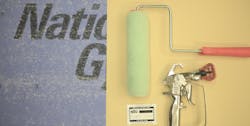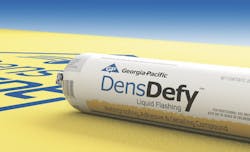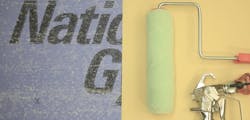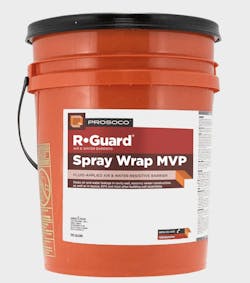Fluid-Applied Sealants—the Future in Moisture Protection?
There was a time when the standard building practice for water and air management in a home was building paper, which evolved into housewraps and tapes. Today, all-in-one systems, such as Huber’s Zip System, LP’s WeatherLogic, and Georgia Pacific’s ForceField, are trending up.
Fluid-applied sealing and waterproofing is the next big thing in exterior protection. The name is self-explanatory: Instead of a substrate with a sticky side, the product comes in a tube, like caulk, or in a sausage or pail and is troweled on. It's versatile enough to be used for window and door openings, building envelope penetrations, and other critical areas in the house.
So, why have liquid-applied sealants caught the attention of many single-family and multifamily builders? Performance, manufacturers say.
Advantages of Fluid-Applied Products
Fluid-applied products are especially useful for areas that are either difficult to seal or waterproof with caulk or tape. And the material is very good at bridging the connection between two dissimilar materials, such as OSB and concrete. The shortcoming of caulk and, in some cases, tape is one reason why building products manufacturer Benjamin Obdyke recently introduced its own fluid-applied flashing product, HydroFlash LA.
“Flashing windows and other areas of the building envelope relies on installer application being near perfect,” says Kaylen Handly, technical and innovations manager for Benjamin Obdyke. “HydroFlash LA makes it easy to create a monolithic seal, which is essential for protecting the home from moisture and air intrusion to avoid long-term performance issues, particularly around window frames.” The product, he continues, is one more way for builders to ensure high-performance levels around vulnerable, hard-to-flash areas such as window openings, HVAC and plumbing penetrations, outlet boxes, and roof-to-wall intersections.
Earlier this year, Georgia-Pacific Building Products joined the ranks of manufacturers offering fluid-applied products, when it released its DensDefy accessories. “Given the ongoing labor shortage in the industry, our customers need products that bridge the gap,” Jason Peace, Georgia-Pacific’s VP of marketing and product management said in a statement announcing the launch. “Our focus is on providing the highest-quality, innovative portfolio of integrated sheathing solutions, while keeping it simple for customers.”
DensDefy liquid flashing membrane seals and protects against water intrusion for transitions between substrates (at rough openings, penetrations, joints, sheathing fasteners, and seams) and unwanted air movement in new or existing wall assemblies, the company explains. It creates an elastomeric flashing membrane that Georgia-Pacific says eliminates the need for joint reinforcing tape.
Still, there’s a catch: Fluid-applied products may be high on performance and effective at keeping out moisture, but they are not cheap, generally costing more than caulk and tapes. To help keep these costs in check, builders may opt to use fluid-applied products only in difficult-to-seal areas and use traditional tape in other applications.
Another thing builders should keep in mind is that fluid-applied products must be installed to the manufacturers’ recommended thickness to be most effective. If the application thickness is inadequate, it could result in poor performance or, worse, potential failure.
Fluid-Applied Sealants and Waterproofing Products
Georgia-Pacific DensDefy Liquid Flashing
DensDefy Liquid Flashing is a complementary product in Georgia-Pacific’s DensElement Barrier System. The flexible, liquid flashing membrane is made with STP Technology, which seals and protects against water intrusion between substrates, including rough openings, penetrations, joints, sheathing fasteners, and seams in new or existing wall assemblies. Available in 20-ounce sausages in cases of 20, the product cures fast (moist cure), has a low-temperature application, and offers a 12-month exposure to normal weather conditions, among other benefits.
Benjamin Obdyke HydroFlash LA
Benjamin Obdyke has expanded its line of flashing products with the addition of HydroFlash LA, which the company says simplifies the process of preparing rough openings, transitions, and seams by creating a monolithic seal, which is essential for protecting the home from moisture and air intrusion and avoiding long-term performance issues, particularly around the window frame. Ideal for filling imperfections, penetrations, and difficult areas, HydroFlash is vapor-permeable and suitable for most climates, including humid environments, such as Florida, and colder regions like the Northeast. It can be left exposed for up to 180 days and cures to a tack-free state suitable for window installation in about 2 to 3 hours.
Huber Zip System Liquid Flash
Huber says its Zip System Liquid Flash offers the ultimate versatility for sealing every rough opening. The fluid-applied product is made of STPE (silyl-terminated polyether) technology, a high-performance formulation that combines the durability of silicones with the toughness of urethanes, Huber explains. The product comes in three options: a 10.3-ounce cartridge, a 20-ounce sausage, and a 29-ounce cartridge.
Sto Gold Coat
Sto Corp. has improved the formulation of its flagship liquid-applied vapor permeable air and moisture barrier, Sto Gold Coat, to have increased opacity to better hide the sheathing, extended UV exposure time (up to six months), and low-temperature application. The ready-mixed flexible air and moisture barrier membrane is applied directly to vertical above-grade wall sheathing and concrete masonry, and functions as a waterproof air barrier when combined with the company’s StoGuard joint and rough-opening treatment. The new product has increased opacity and extended UV exposure.
Prosoco Spray Wrap MVP
Spray Wrap MVP from Prosoco is a fluid-applied air and water-resistive barrier that stops air and water leakage in cavity wall, masonry veneer construction, as well as in stucco, EIFS and most other building wall assemblies. It can be used as the primary air barrier over above-grade wall assemblies prepared with joint and seam filler. The company says it reduces condensation and energy loss caused by air leaks through the wall assembly and allows moisture that accumulates within the wall assembly to dry.





